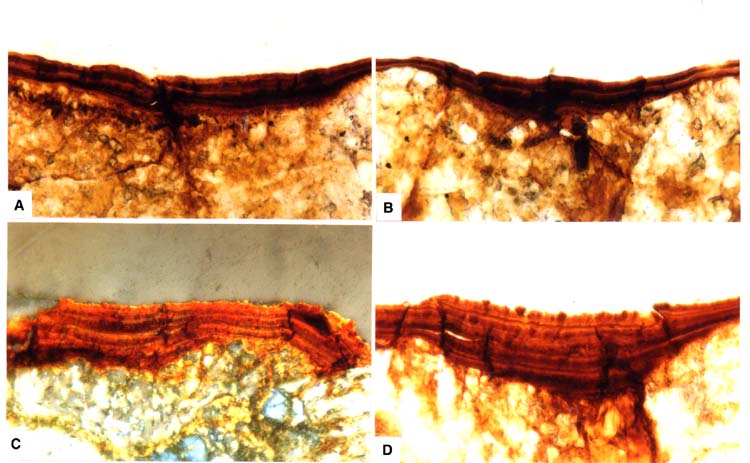

Figure Caption Regionally replicated microstratigraphies in varnish samples from the north flank of Tian Shan in the Gürbantongüt Desert, western China. (A) and (B): varnish from I-2 terrace surfaces of Hutubi He, 6.5 m above the active washes and probably of latest Pleistocene/early Holocene age. (C) and (D): varnish from I-3 terrace surfaces of Hutubi He, 9 m above the active washes and probably of latest Pleistocene age. The two dark layers in (A) and (B) and the upper two dark layers in (C) and (D) likely represent early and late Holocene wet phases that occurred at 8.0-6.0 and 4.5-2.5 C-14 ka, respectively, in the region. Maximum varnish thicknesses (in µm) are 25 (A, B), 40 (C), and 50 (D).
| (A) | (B) |
| (C) | (D) |
Figure Caption Regionally replicated microstratigraphies in varnish samples from the west bank of the Dead Sea Rift, Israel. (A) and (B): Varnish from lower post-Lisan shorelines at Nahal Darga. (C) and (D): Varnish from higher post-Lisan shorelines at Nahal Zeelim. The dark layers in the lower portions of the varnish microstratigraphies in (A) and (B) likely represent early Holocene wet phases in the region, and the two dark layers in the lower portions of the varnish microstratigraphies in (C) and (D) likely represent latest Pleistocene Younger Dryas-aged wet phases. Maximum varnish thicknesses (in µm) are 70 (A), 90 (B), 55 (C), and 50 (D).
| (A) | (B) |
| (C) | (D) |
Figure Caption Regionally replicated microstratigraphies in varnish samples from the Patagonia Desert, Argentina. (A) and (B): Varnish from morainal boulders in Rio Mendoza Valley. (C) and (D): Varnish from morainal boulders in Rio Atuel Valley. The dark layers in the upper portions of the varnish microstratigraphies in (A) and (B) likely represent late Holocene Neoglacial wet phases in the region, and the two dark layers in the lower portions of the varnish microstratigraphies in (A) through (D) likely represent latest Pleistocene wet phases. Maximum varnish thicknesses (in µm) are 80 (A), 90 (B), 50 (C), and 55 (D).
| (A) | (B) |
| (C) | (D) |
Figure Caption Varnish microstratigraphies from early-to-middle Holocene alluvial-fan surfaces near Beltana, South Australia. Maximum varnish thicknesses (in µm) are 125 (A), 125 (B), 85 (C), and 100 (D).
| (A) | (B) |
| (C) | (D) |
Figure Caption Varnish microstratigraphies from the Indus River Valley, Pakistan. (A) and (B): Varnish from bedrock surfaces on the north bank of the Indus River near Skardu. (C) and (D): Varnish from bedrock surfaces near Chilas. Maximum varnish thicknesses (in µm) are 40 (A), 50 (B), 120 (C), and 70 (D).